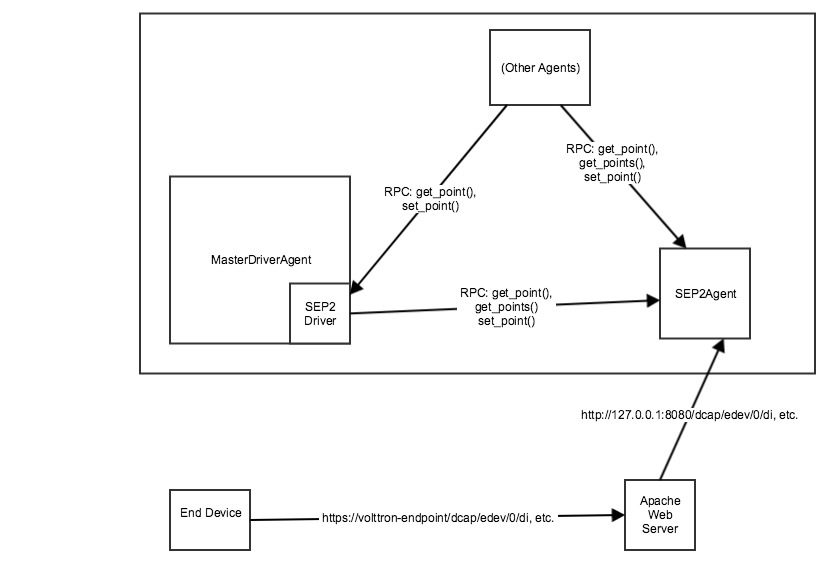IEEE 2030.5 DER Support¶
Version 1.0
Smart Energy Profile 2.0 (SEP2, IEEE 2030.5) specifies a REST architecture built around the core HTTP verbs: GET, HEAD, PUT, POST and DELETE. A specification for the IEEE 2030.5 protocol can be found here.
IEEE 2030.5 EndDevices (clients) POST XML resources representing their state, and GET XML resources containing command and control information from the server. The server never reaches out to the client unless a “subscription” is registered and supported for a particular resource type. This implementation does not use IEEE 2030.5 registered subscriptions.
The IEEE 2030.5 specification requires HTTP headers, and it explicitly requires RESTful response codes, for example:
- 201 - “Created”
- 204 - “No Content”
- 301 - “Moved Permanently”
- etc.
IEEE 2030.5 message encoding may be either XML or EXI. Only XML is supported in this implementation.
IEEE 2030.5 requires HTTPS/TLS version 1.2 along with support for the cipher suite TLS_ECDHE_ECDSA_WITH_AES_128_CCM_8. Production installation requires a certificate issued by a IEEE 2030.5 CA. The encryption requirement can be met by using a web server such as Apache to proxy the HTTPs traffic.
IEEE 2030.5 discovery, if supported, must be implemented by an xmDNS server. Avahi can be modified to perform this function.
Function Sets¶
IEEE 2030.5 groups XML resources into “Function Sets.” Some of these function sets provide a core set of functionality used across higher-level function sets. This implementation implements resources from the following function sets:
- Time
- Device Information
- Device Capabilities
- End Device
- Function Set Assignments
- Power Status
- Distributed Energy Resources
Distributed Energy Resources¶
Distributed energy resources (DERs) are devices that generate energy, e.g., solar inverters, or store energy, e.g., battery storage systems, electric vehicle supply equipment (EVSEs). These devices are managed by a IEEE 2030.5 DER server using DERPrograms which are described by the IEEE 2030.5 specification as follows:
Servers host one or more DERPrograms, which in turn expose DERControl events to DER clients. DERControl instances contain attributes that allow DER clients to respond to events that are targeted to their device type. A DERControl instance also includes scheduling attributes that allow DER clients to store and process future events. These attributes include start time and duration, as well an indication of the need for randomization of the start and / or duration of the event. The IEEE 2030.5 DER client model is based on the SunSpec Alliance Inverter Control Model [SunSpec] which is derived from IEC 61850-90-7 [61850] and [EPRI].
EndDevices post multiple IEEE 2030.5 resources describing their status. The following is an example of a Power Status resource that might be posted by an EVSE (vehicle charging station):
<PowerStatus xmlns="http://zigbee.org/sep" xmlns:xsi="http://www.w3.org/2001/XMLSchema-instance" href="/sep2/edev/96/ps">
<batteryStatus>4</batteryStatus>
<changedTime>1487812095</changedTime>
<currentPowerSource>1</currentPowerSource>
<estimatedChargeRemaining>9300</estimatedChargeRemaining>
<PEVInfo>
<chargingPowerNow>
<multiplier>3</multiplier>
<value>-5</value>
</chargingPowerNow>
<energyRequestNow>
<multiplier>3</multiplier>
<value>22</value>
</energyRequestNow>
<maxForwardPower>
<multiplier>3</multiplier>
<value>7</value>
</maxForwardPower>
<minimumChargingDuration>11280</minimumChargingDuration>
<targetStateOfCharge>10000</targetStateOfCharge>
<timeChargeIsNeeded>9223372036854775807</timeChargeIsNeeded>
<timeChargingStatusPEV>1487812095</timeChargingStatusPEV>
</PEVInfo>
</PowerStatus>
Design Details¶

VOLTTRON’s IEEE 2030.5 implementation includes a IEEE2030_5Agent and a IEEE 2030.5 device driver, as described below.
VOLTTRON IEEE2030_5Agent¶
IEEE2030_5Agent implements a IEEE 2030.5 server that receives HTTP POST/PUT requests from IEEE 2030.5 devices. The requests are routed to IEEE2030_5Agent over the VOLTTRON message bus by VOLTTRON’s MasterWebService. IEEE2030_5Agent returns an appropriate HTTP response. In some cases (e.g., DERControl requests), this response includes a data payload.
IEEE2030_5Agent maps IEEE 2030.5 resource data to a VOLTTRON IEEE 2030.5 data model based on SunSpec, using block numbers and point names as defined in the SunSpec Information Model, which in turn is harmonized with 61850. The data model is given in detail below.
Each device’s data is stored by IEEE2030_5Agent in an EndDevice memory structure. This structure is not persisted to a database. Each EndDevice retains only the most recently received value for each field.
IEEE2030_5Agent exposes RPC calls for getting and setting EndDevice data.
VOLTTRON IEEE 2030.5 Device Driver¶
The IEEE 2030.5 device driver is a new addition to VOLTTRON MasterDriverAgent’s family of standard device drivers. It exposes get_point/set_point calls for IEEE 2030.5 EndDevice fields.
The IEEE 2030.5 device driver periodically issues IEEE2030_5Agent RPC calls to refresh its cached representation of EndDevice data. It issues RPC calls to IEEE2030_5Agent as needed when responding to get_point, set_point and scrape_all calls.
Field Definitions¶
These field IDs correspond to the ones in the IEEE 2030.5 device driver’s configuration file, ieee2030_5.csv. They have been used in that file’s “Volttron Point Name” column and also in its “Point Name” column.
Revising and Expanding the Field Definitions¶
The IEEE 2030.5-to-SunSpec field mappings in this implementation are a relatively thin subset of all possible field definitions. Developers are encouraged to expand the definitions.
The procedure for expanding the field mappings requires you to make changes in two places:
- Update the driver’s point definitions in services/core/MasterDriverAgent/master_driver/ieee2030_5.csv
- Update the IEEE 2030.5-to-SunSpec field mappings in services/core/IEEE2030_5Agent/ieee2030_5/end_device.py and __init__.py
When updating VOLTTRON’s IEEE 2030.5 data model, please use field IDs that conform to the SunSpec block-number-and-field-name model outlined in the SunSpec Information Model Reference (see the link below).
For Further Information¶
SunSpec References:
- Information model specification: http://sunspec.org/wp-content/uploads/2015/06/SunSpec-Information-Models-12041.pdf
- Information model reference spreadsheet: http://sunspec.org/wp-content/uploads/2015/06/SunSpec-Information-Model-Reference.xlsx
- Inverter models: http://sunspec.org/wp-content/uploads/2015/06/SunSpec-Inverter-Models-12020.pdf
- Energy storage models: http://sunspec.org/wp-content/uploads/2015/06/SunSpec-Energy-Storage-Models-12032.pdf
Questions? Please contact:
- Rob Calvert (rob@kisensum.com) or James Sheridan (james@kisensum.com)